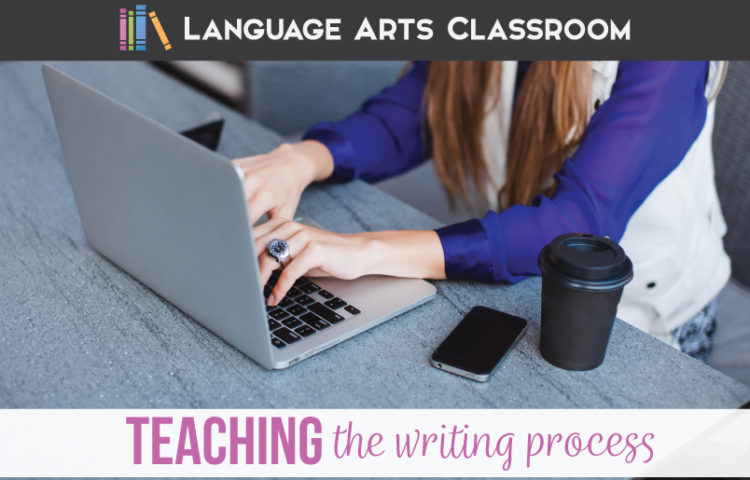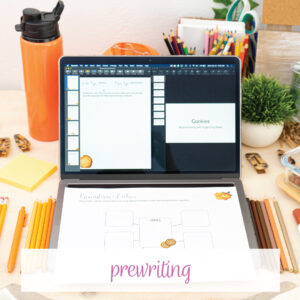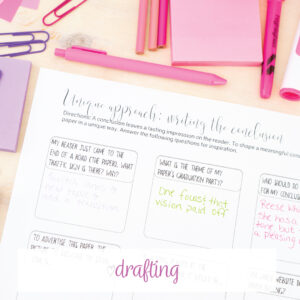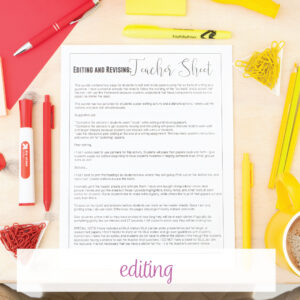Teaching the writing process? I model the writing process for my students, errors, mistakes, frustrations, and all.
We all want young writers to understand steps of the writing process and to personalize the process for their own writing. In all of my experiences, writing alongside classes accomplishes these goals.
Why? Well, I think writing longhand (letters and correspondences) has largely been removed from our society. Students don’t see their parents write a rough draft to the insurance company or read over a letter to a friend. So when teachers ask them to embark on the writing process, they draw a blank. Students see adults sit at computers and type.
And nothing is wrong with that! Still, students need to approach writing a large paper differently than typing a quick email. Teaching the writing process through modeling builds a collaborative classroom setting for future writing assignments.
Teaching writing is a complex process because so many ways exist to write, and every student needs a different one. For instance, I am a freestyler, brainstorming a list and then write a rough draft. I often then circle back to prewriting/brainstorming to better my ideas and in the process, write another rough draft.
Do I have time for teaching the writing process this way?
Yes. It may seem like lots of extra work, but when I model generating ideas, drafting, and on, classes have an example, and they can see that even a teacher does not simply sit down and write a paper; writing is lots of work!
In the process, we build connections as students see me stumble over word choice and punctuation. Like any other writer, I doubt myself at times. Classes appreciate that authenticity.
Overall process.
Writing is recursive, not linear, so when I start teaching the writing process with a class, I encourage them to stick to a basic writing process:
1. Prewriting/Brainstorming
2. Drafting
3. Revising/Editing
4. Editing
5. Publishing
As a class and individuals grow, they start to stray from the process and loop back and forth until they get the desired outcome. I think allowing students this freedom as an English class continues throughout the year shows my trust in students’ developments.
To walk through that writing process together, we write together.
You can use any topic, but I often choose a fun one: cookies. Students feel comfortable talking about cookies, they have prior knowledge, and we then have an inside joke we can reference for the semester. Of course, you can use any topic to write with your students, but my go-to topic is cookies. Through these writing process activities, I also strive to build a sense of community.
I want students to be comfortable providing feedback with their peers’ papers, and when I work toward a community of writers, I find great success.
1. Brainstorming and prewriting methods:
To begin, I provide an assortment of ways for students to prewrite. (I may be forgetting some that I use, and also feel free to add more ideas in the comments!)
- Outline
- List
- Comparison/Contrast chart
- Web graphic organizer
- Problem/Solution chart
- Sandwich/Hamburger chart (often used with my junior high students – high school kids don’t seem to care for this)
- Multiple other graphic organizers
What I have found helps students the most is that I complete this activity with them. They see me struggle for ideas and come up with ideas that don’t connect well with my topic; they see me get frustrated when I have to mark out concepts and rearrange them; they watch me arrange my prewriting into different categories, which will become my different paragraph; they learn that prewriting is messy, unorganized, and frustrating at points.
I’m a big “bulleted list” person: For cookies, I would consider all of the different kinds (sugar, chocolate, sour cream, snickerdoodle), the ingredients, the seasons and holidays, the calories, all of it! I know that I won’t write about that many topics, but I want to show students that my paper and thought process benefits when I took time to articulate and brainstorm everything about the topic.
Looking for more writing process activities? This blog post deals with brainstorming and prewriting.
2. Drafting methods:
Students have even seen me change my mind about a topic and start over, have seen my excitement when I am onto a great idea, and have seen my thought process as I pre-write.
I continue demonstrating my writing process with drafting. I show students how I long-hand, write out my rough draft. Some of my students prefer to type their rough drafts, and that is fine. (I assign students to complete every part of the writing process, but to personalize each section to fit their needs and personalities.) Plus, I allow students to read mine while I read their drafts. Yes, we trade and discuss paragraph organization and transitions and what works and what doesn’t.
This part of teaching the writing process shows them that no rough draft is perfect, it is a working draft. Mine has mistakes and I encourage my class to offer suggestions. This also provides students an opportunity for practicing giving and receiving constructive feedback.
With cookies, I verbalize my process for narrowing down the draft for my topic. I could write a book on the history of cookies, how to bake cookies, holiday cookies, and more. Instead, writing about different types of cookies provides a narrow topic. Each type of cookie will be a body paragraph, leading to clarity, especially in the topic sentence.
Looking for more writing process activities? This blog post is entirely dedicated to helping students draft their essays.
3. Revising methods:
During revision, I often head back to my prewriting to be sure that I can’t better organize the paper. Sometimes I missed a point that I now see the perfect spot to insert. As I model the writing process and its revision methods, I also have an opportunity to reflect on what I want the overall message of the paper to be, and to see if I am hitting that mark. (I often verbalize these ideas in front of students.) Then I type my paper, and yep, I sit right beside my students and type with them.
As I write about cookies, I might become frustrated. If I choose to write an informative paper for modeling, I show students how I naturally include first person. To delete and edit that, I model for students how to rearrange cookie sentences to make them formal.
Looking for more writing process activities? This blog post is entirely dedicated to making student revising meaningful.
4. Editing methods:
Dependent upon the age group, time limits, and class attitude, I have students proofread or edit in a variety of ways:
- As a class, students develop criteria for proofreading. The large umbrella for criteria can focus on focus, support, organization, or conventions, all or some. This manner works well for struggling writers because then everyone can focus on one aspect. Classes who write well can focus on all of them. Small groups can check each other’s work and their own.
- I provide a checklist for students. Students then check their own, a partner’s, or a group’s work.
- We proofread as a class. This works well with a close-knit class, one that is willing to participate and share writing samples. Students volunteer sentences they need help reworking, or read a section of their papers that need reformed.
Again, I share with students my ways of proofreading, checking punctuation with sentence structure, and checking other grammatical rules. I even rotation with them during stations.
Looking for more writing process activities? This blog post is entirely dedicated to making student editing meaningful.
5. Publication methods:
For high school students, this typically includes printing or submitting. It can also include presenting part of the paper to practice speaking skills or turning some of the information into a power-point. Sometimes, I ask students to print their papers and display them on a bulletin board. I will make a simple display and invite them to share their papers. That way, I am not in charge of this final stage of the writing process, and students don’t need to share if they do not feel like doing so.
With my middle school students, I’ve found they really enjoy turning their writing into artistic endeavors. For instance, they can add pictures or graphics to a poster that help emphasize and explain their writing. I have also made a digital portfolio using Google Slides and shared it with the class.
Students contribute to my cookie paper, and they enjoy reading it. It becomes a published paper they can consult, one that I modeled and took their advice in developing.
Looking for more writing process activities? This blog post is entirely dedicated to publishing student work.
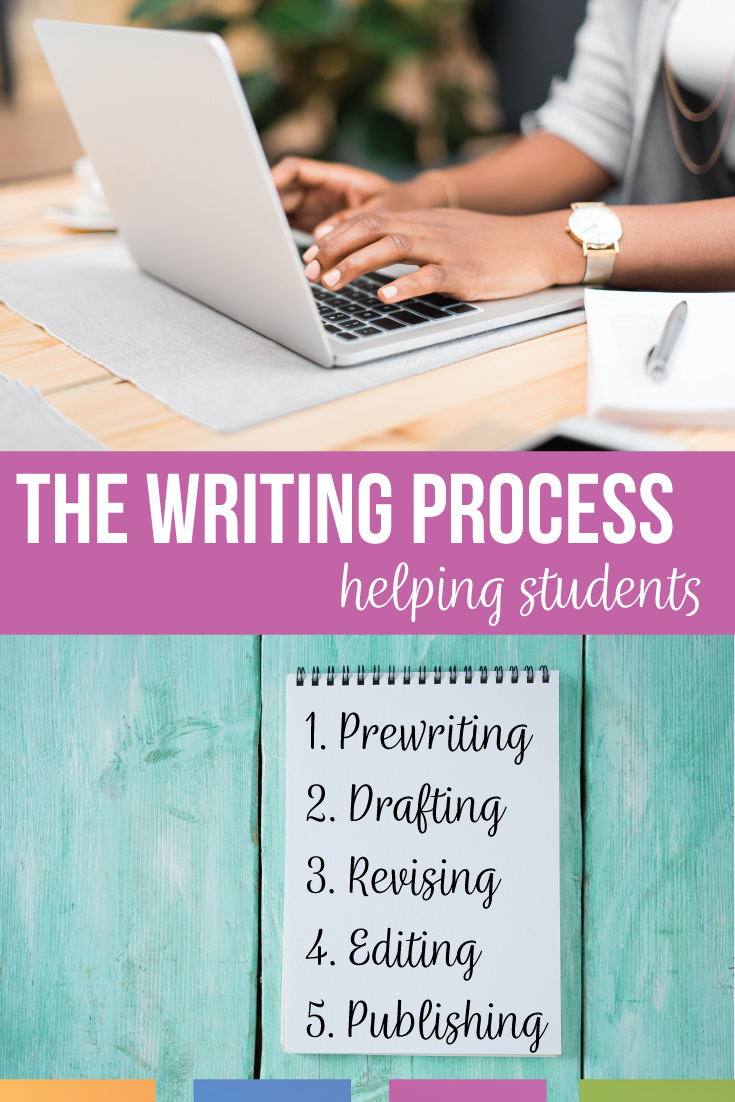
It may seem that your writing lesson plans will be extensive and create more work for the teacher, that perhaps you will become tired as you model the writing process. I’ve found the opposite. By modeling writing, revising, and the entire process with students, they understand expectations better. Their papers are of higher quality.
Finally, the more I teach writing, the more I find that reflecting on the writing process with students is an important step. At the end of an assignment, we spend time discussing what went well and what students have learned as writers. Teaching the writing process requires a reflection too.
These ideas cover how I teach the writing process in my English language arts classroom. Do you have any other tips to offer? Other ideas to incorporate with the writing process?

